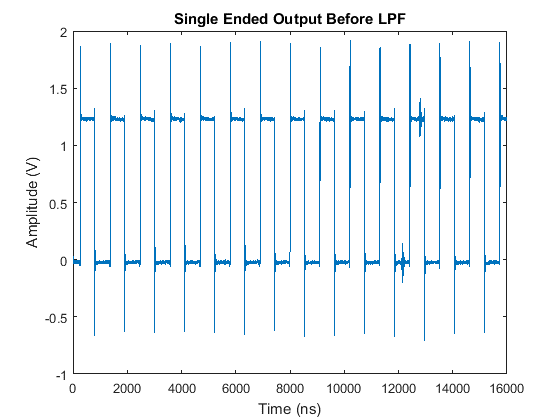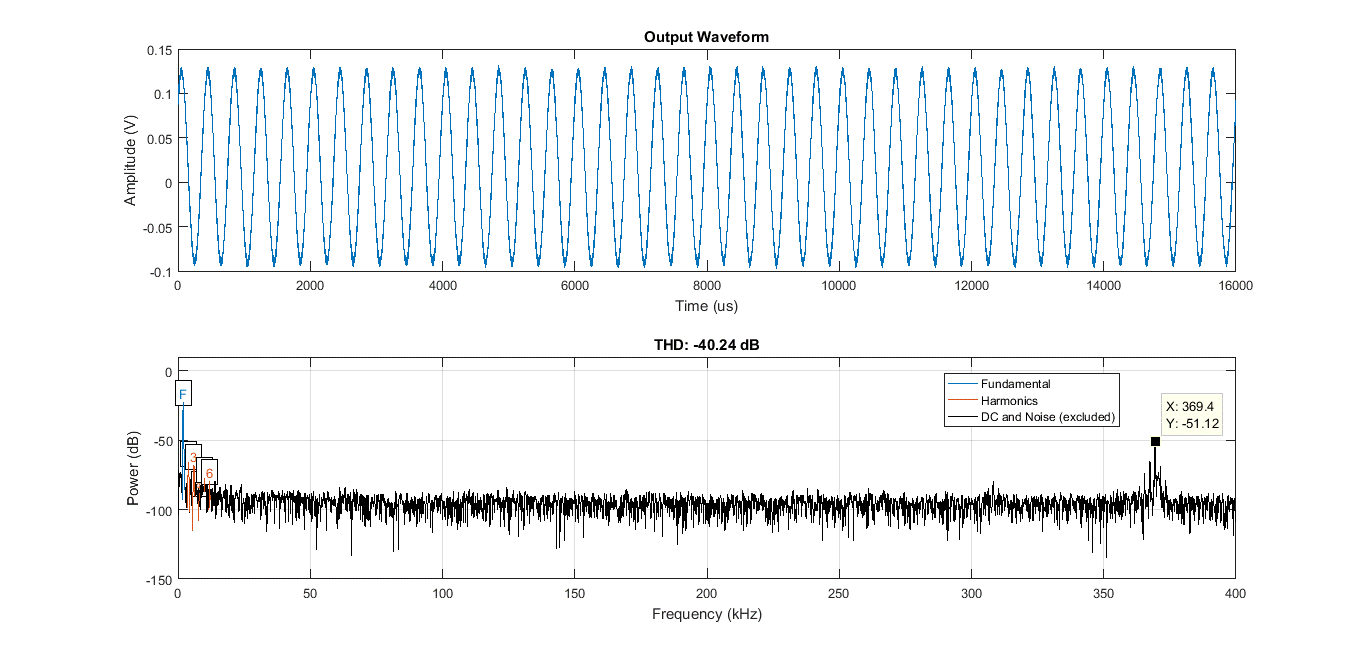TESTING
The initial testing steps included:
1. Checking the bias voltage across bias current variation.

| Vtest(V) | Vbias(V) | I(uA) |
|---|---|---|
| 1.116 | 0.399V | 8.2 |
| 1.046 | 0.453 | 15.4 |
| 1.026 | 0.466 | 17.4 |
| 1.006 | 0.479 | 19.4 |
| 0.966 | 0.504 | 21.7 |
| 0.781 | 0.597 | 49.5 |
| 0.677 | 0.642 | 52.3 |
| 0.652 | 0.652 | 54.8 |
2. Variation of switching frequencies across scan chain bits
| Scan chain bits | Frequency of triangle wave (KHz) |
|---|---|
| 11111 | 367 |
| 11110 | 360 |
| 11100 | 354 |
| 11000 | 344 |
| 10000 | 326 |
| 00000 | 285 |
3. Variaton of duty cycle with input voltage

Figure 2: Pulse Width Modulated wave before Low Pass Filtering
| Vin (mV) | Duty Cycle (%) |
|---|---|
| 100 | 39.2-53.2 |
| 200 | 33.7-62.1 |
| 300 | 27.1-70.2 |
4. Summary of measurement results
Total Harmonic Distortion is claculated by taking the Discrete Fourier Transform of the output signal after the low-pass filter.

Figure 3: Sampling frequency = 369kHz; closed loop gain of 2 ; Vin= 100mVpp ; Fin = 4 kHz
Total Harmonic Distortion vs Input Frequency
THD is a strong function of input frequency. This can see below, as the input frequency increases, the in-band harmonic suppression in the loop goes down affecting the THD. Also, with increasing Input frequency, the dead-time is a bigger fraction of the input period. Which further decrease the linearity.
| Input frequency (Hz) | THD (dB) |
|---|---|
| 500 | -56.78 |
| 1000 | -47.67 |
| 2000 | -30.58 |
| 4000 | -17.2 |
Power Efficiency vs Input Frequency
Power Efficiency is also function of input frequency. This can see below, as the input frequency increases, the switching losses in buffers and drivers increase
| Input frequency (Hz) | Power Efficiency(%) |
|---|---|
| 500 | 88.92 |
| 1000 | 81.12 |
| 2000 | 50.4 |
| 4000 | 41.8 |
Total Harmonic Distortion vs Input Voltage
THD is a function of input voltage because the swing of the triangular wave is limited and Input exccursions outside this swing limit is not properly translated to PWM signal.
| Input Voltage (mVpp) | THD (dB) |
|---|---|
| 100 | -40.82 |
| 200 | -27.67 |
| 300 | -22.34 |
| 400 | -20.06 |
Power Efficiency vs Vin
| Input Voltage (mVpp) | Power Efficiency(%) |
|---|---|
| 100 | 76.7 |
| 200 | 86.13 |
| 300 | 75.06 |
| 400 | 56.71 |
Non-overlapping window vs THD (Vin = 100mV & Fin = 4 KHz Fs = 369.4 KHz)
As described earlier. Non-overlap window affects the linearity of the output since the the dead-time addition is non-linear to PWM signal
| Non-overlap settings (ns) | THD(dB) |
|---|---|
| 1 | -40.81 |
| 10 | -39.26 |
| 15 | -37.19 |
Sampling frequency vs THD (Vin = 100mV & Fin = 4 KHz)
| Sampling frequency (KHz) | THD(dB) |
|---|---|
| 369 | -40.81 |
| 365 | -39.26 |
| 359 | -37.19 |
| 347 | -40.52 |
| 288 | -39.87 |
